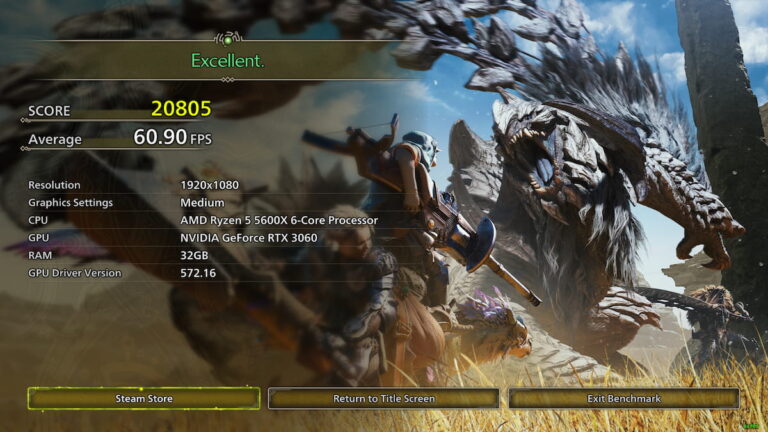The gaming landscape, mainly that of PC, has changed considerably in recent years. For better or worse, we have many options that let some of us potato-rig players play in a somewhat acceptable way. However, that comes at a hefty price. Some developers tend to release their games in the most unoptimized way possible. Most just wait for DLSS to do the heavy lifting. However, in other cases, companies like Capcom do surprisingly consumer-friendly actions, such as the Monster Hunter Wilds benchmark. Not only did it let us see how well our PCs ran the game, but it also helped us pick the right platform to enjoy this new installment.
The Monster Hunter Wilds Benchmark Is a Refreshing Move in an Anti-Consumer Gaming Market

While I am praising the Monster Hunter Wilds benchmark, the reality is that this game isn’t the only one that has done it. MMOs like FFXIV always release a benchmark ahead of an expansion. So, it isn’t something new in the market. However, it is surprising to see one. Especially in cases where many companies launch a poorly optimized half-baked game, leaving everything to “post-launch” content that will “elevate the game as it was initially intended.” For that reason, seeing a benchmark tool, especially for a game as big as Wilds, is refreshing.
Take my case, for example. I don’t have the best rig, but I thought it would be enough to run Monster Hunter Wilds. At least I didn’t experience the low-poly Arkveld fight, so I call that a win. Still, my frames dropped considerably, and my PC fans were spinning like crazy. While I got an “Excellent” score in the benchmark, I decided to pre-order the game for PS5 because I thought playing it on a console would be much better.
Without Cross-Platform Options at Launch, Things Might’ve Been Different
The one thing that hit me as I looked at the benchmark was that things might’ve been different if Monster Hunter Wilds didn’t have cross-platform options at launch. Those who only have a PC have to stick with it regardless of how the game runs. However, those with more than one platform at home can pick the one that runs the game better and not worry about leaving their friends behind. Again, this is another consumer-friendly move from Capcom, especially since many struggled to play with others in Rise and World.
The sentiment might still be the same in the end. Yes, the game runs poorly on your rig, but at least you know before making a purchase. Plus, the open betas have provided players with a rough estimation of how the monster-slaying action will look on their PCs. Yet, everyone can make a more informed choice now after trying the game, even if it isn’t the final build. On the other hand, those with a PC and other consoles can select which platform to spend their money on. That’s something that not every company offers. Most of the time, you wait for a review on your preferred platform and then decide. Here, Capcom is giving everyone hands-on experience and the freedom of choice before spending their money, and that’s a terrific approach.
Ultimately, I just wished more companies did this. There are many games out there that look fantastic, but we never get to experience them until we buy them. Even if a reviewer experiences a game on your platform, that doesn’t mean you’ll get the same experience. But now, everyone knows a bit more about how Monster Hunter Wilds will perform, thanks to the benchmark and the beta. Hopefully, Capcom will continue to do this for its next games, or at least those that have a huge world like Wilds.
